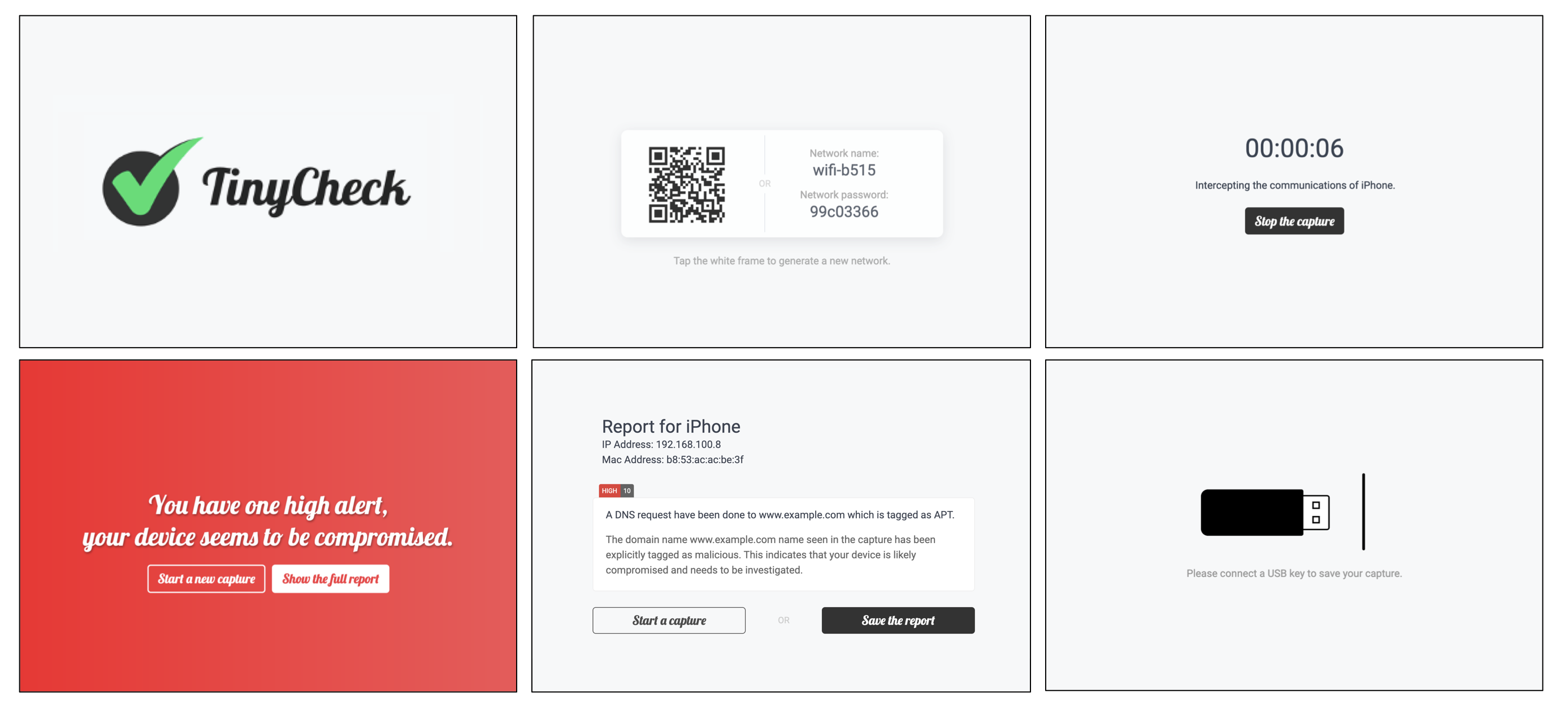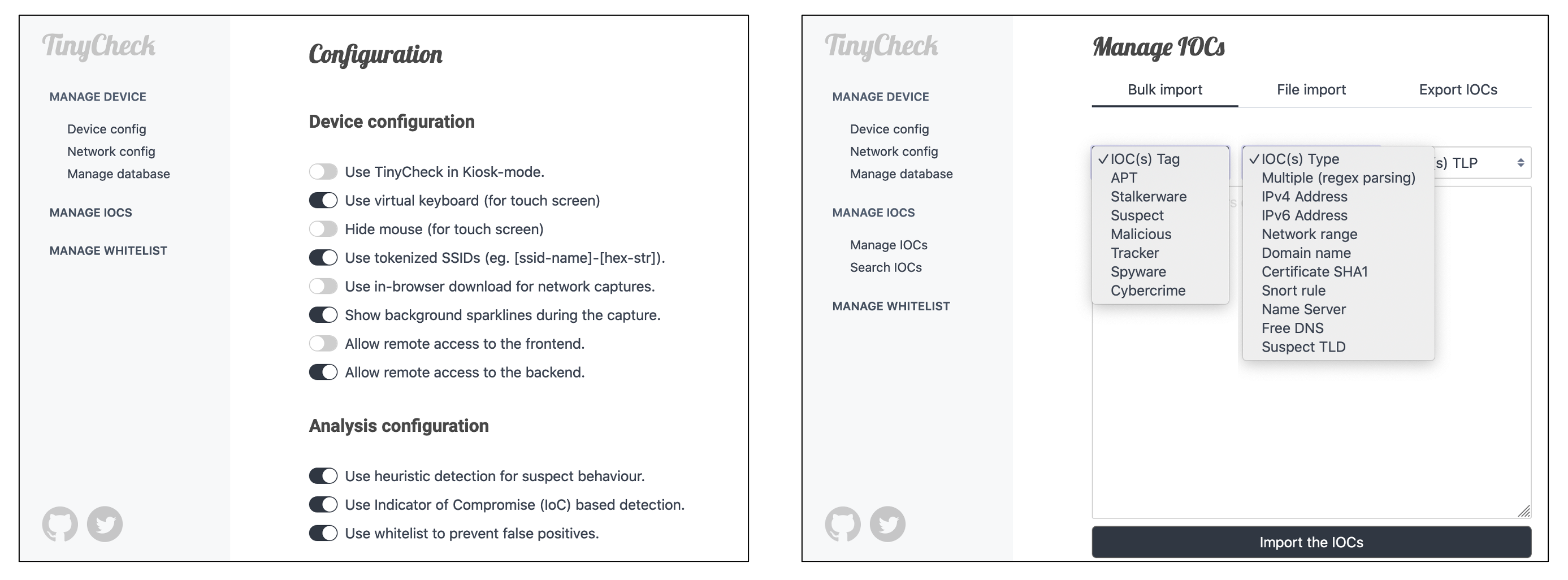TinyCheck
Description
TinyCheck allows you to easily capture network communications from a smartphone or any device which can be associated to a Wi-Fi access point in order to quickly analyze them. This can be used to check if any suspect or malicious communication is outgoing from a smartphone, by using heuristics or specific Indicators of Compromise (IoCs).
In order to make it working, you need a computer with a Debian-like operating system and two Wi-Fi interfaces. The best choice is to use a Raspberry Pi (3+) with a Wi-Fi dongle and a small touch screen. This tiny configuration (for less than $50) allows you to tap any Wi-Fi device, anywhere.
History
The idea of TinyCheck came to me in a meeting about stalkerware with a French women's shelter. During this meeting we talked about how to easily detect stalkerware without installing very technical apps nor doing forensic analysis on them. The initial concept was to develop a tiny kiosk device based on Raspberry Pi which can be used by non-tech people to test their smartphones against malicious communications issued by stalkerware or any spyware.
Of course, TinyCheck can also be used to spot any malicious communications from cybercrime or state-sponsored implants. It allows the end-user to push his own extended Indicators of Compromise via a backend in order to detect some ghosts over the wire.
Use cases
TinyCheck can be used in several ways by individuals and entities:
- Over a network - TinyCheck is installed on a network and can be accessed from a workstation via a browser.
- In kiosk mode - TinyCheck can be used as a kiosk to allow visitors to test their own devices.
- Fully standalone - By using a powerbank, you can tap any device anywhere.
Few steps to analyze your smartphone
- Disable mobile aka. cellular data
Disable the 3G/4G data link in your smartphone configuration. - Close all the opened applications
This to prevent some FP. Can be good also to disable background refresh for the messaging/dating/video/music apps. - Connect your smartphone to the WiFi network generated by TinyCheck
Once connected to the Wi-Fi network, its advised to wait like 10-20 minutes. - Interact with your smartphone
Send an SMS, make a call, take a photo, restart your phone - some implants might react to such events. - Stop the capture
Stop the capture by clicking on the button. - Analyze the capture
Analyze the captured communication, enjoy (or not). - Save the capture
Save the capture on an USB key or by direct download.
Architecture
TinyCheck is divided in three independent parts:
- A backend: where the user can add his own extended IOCs, whitelist elements, edit the configuration etc.
- A frontend: where the user can analyze the communication of his device by creating an ephemeral WiFi AP.
- An analysis engine: used to analyze the pcap by using Zeek, Suricata, extended IOCs and heuristics.
The backend and the frontend are quite similar. Both consist of a VueJS application (sources stored under /app/) and an API endpoint developed in Flask (stored under /server/). The data shared between the backend and the frontend are stored under the config.yaml file for configuration and tinycheck.sqlite3 database for the whitelist/IOCs.
It is worthy to note that not all configuration options are editable from the backend (such as default ports, Free certificates issuers etc.). Don't hesitate to take a look at the config.yaml file to tweak some configuration options.
Installation
Prior the TinyCheck installation, you need to have:
- A Raspberry Pi with Raspberry Pi OS (or any computer with a Debian-like system)
- Two working Wi-Fi interfaces (check their number with
ifconfig | grep wlan | wc -l). - A working internet connection
- (Adviced) A small touchscreen previously installed for the kiosk mode of TinyCheck.
$ cd /tmp/
$ git clone https://github.com/KasperskyLab/TinyCheck
$ cd TinyCheck
$ sudo bash install.sh
By executing install.sh, all the dependencies associated to the project will be installed and it can take several minutes depending of your internet speed. Four services are going to be created:
tinycheck-backendexecuting the backend server & interface;tinycheck-frontendexecuting the frontend server & interface;tinycheck-kioskto handle the kiosk version of TinyCheck;tinycheck-watchersto handle the watchers which update automatically IOCs / whitelist from external URLs;
Once installed, the operating system is going to reboot.
Meet the frontend
The frontend - which can be accessed from http://tinycheck.local - is a kind of tunnel which help the user throughout the process of network capture and reporting. It allows the user to setup a Wi-Fi connection to an existing Wi-Fi network, create an ephemeral Wi-Fi network, capture the communications and show a report to the user... in less than one minute, 5 clicks and without any technical knowledge.
Meet the backend
Once installed, you can connect yourself to the TinyCheck backend by browsing the URL https://tinycheck.local and accepting the SSL self-signed certificate.
The backend allows you to edit the configuration of TinyCheck, add extended IOCs and whitelisted elements in order to prevent false positives. Several IOCs are already provided such as few suricata rules, FreeDNS, Name servers, CIDRs known to host malicious servers and so on. In term of extended IOCs, this first version of TinyCheck includes:
- Suricata rules
- CIDRs
- Domains & FQDNs (named generically "Domains")
- IPv4 / IPv6 Addresses
- Certificates sha1
- Nameservers
- FreeDNS
- Fancy TLDs
Meet the analysis engine
The analysis engine is pretty straightforward. For this first version, the network communications are not analyzed in real time during the capture. The engine executes Zeek and Suricata against the previously saved network capture. Zeek is a well-known network dissector which stores in several logs the captured session.
Once saved, these logs are analysed to find extended IOCs (listed above) or to match heuristics rules (which can be deactivated through the backend). The heuristics rules are hardcoded in zeekengine.py, and they are listed below. As only one device is analyzed at a time, there is a low probability to see heuristic alerts leveraged.
- UDP/ICMP going outside the local network
- UDP/TCP connection with a destination port >1024
- Remote host not resolved by DNS during the session
- Use of self-signed certificate by the remote host
- SSL connection done on a non standard port
- Use of specific SSL certificates issuers by the remote host (such as Let's Encrypt)
- HTTP requests done during the session
- HTTP requests done on a non standard port
- ...
On the Suricata part, the network capture is analysed against suricata rules saved as IOCs. Few rules are dynamics such as:
- Device name exfiltred in clear-text;
- Access point SSID exfiltred in clear-text;
Watchers?
In order to keep IOCs and whitelist updated constantly, TinyCheck integrates something called "watchers". It is a very simple service with few lines of Python which grabs new formated IOCs or whitelist elements from public URLs. As of today, TinyCheck integrates two urls, one for the whitelist and one for the IOCs (The formated files are present in the assets folder).
If you have seen something very suspicious and/or needs to be investigated/integrated in one of these two lists, don't hesitate to ping us. You can also do you own watcher. Remember, sharing is caring.
Q&As
Your project seem very cool, does it send data to Kaspersky or any telemetry server?
No, at all. You can look to the sources, the only data sent by TinyCheck is an HTTP GET request to a website that you can specify in the config, as well as the watchers URLs. Kaspersky don't - and will not - receive any telemetry from your TinyCheck device.
Can you list some hardware which can be used with this project (touch screen, wifi dongle etc.)?
Unfortunately, we prefer to not promote any hardware/constructor/website on this page. Do not hesitate to contact us if you want specific references.
I'm not very confortable with the concept of "watchers" as the IOCs downloaded are public. Do you plan to develop a server to centralize AMBER/RED IOCs?
Yes, if the demand is felt by NGOs (contact us!). Is it possible to develop this kind of thing, allowing you to centralize your IOCs and managing your fleet of TinyCheck instances on a server that you host. The server can also embed better detection rules thanks to the telemetry that it will receive from devices.
Possible updates for next releases
- Centralized server for IOC/whitelist management (aka. Remote Analysis).
- Implement Ethernet use.
- PDF reports.
- Possibility to add watchers from the backend interface.
- Encryption of ZIPed reports.
- Better frontend GUI/JS (use of websockets / better animations).
- More OpSec (TOR integration, Local IP randomization etc.)
- 3d template for kiosks ?
Special thanks
Guys who provided some IOCs
- Cian Heasley for his android stalkerwares IOC repo, available here: https://github.com/diskurse/android-stalkerware
- Te-k for his stalkerwares awesome IOCs repo, available here: https://github.com/Te-k/stalkerware-indicators
- Emilien for his Stratum rules, available here: https://github.com/kwouffe/cryptonote-hunt
- Costin Raiu for his geo-tracker domains, available here: https://github.com/craiu/mobiletrackers/blob/master/list.txt
Code review
- Dan Demeter @_xdanx
- Maxime Granier
- Florian Pires @Florian_Pires
- Ivan Kwiatkowski @JusticeRage
Others
- GReAT colleagues.
- Tatyana, Kristina, Christina and Arnaud from Kaspersky (Support and IOCs)
- Zeek and Suricata awesome maintainers.
- virtual-keyboard.js.org & loading.io guys.
- Yan Zhu for his awesome Spectre CSS lib (https://picturepan2.github.io/spectre/)


